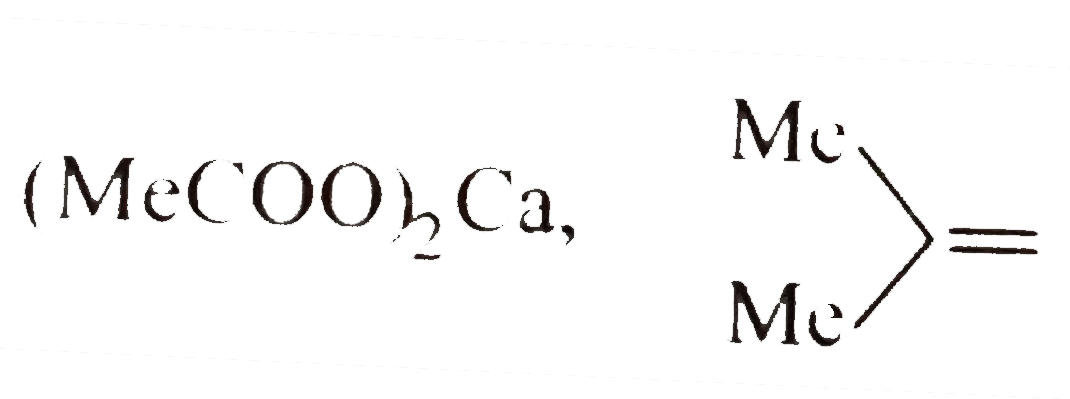Identify the set from the following which connot form acetone in a single-step reaction.
a.
b.
c.(MeCOO)2Ca,Me−≡−H
d.
The correct Answer is:D
To solve the question of which set cannot form acetone in a single-step reaction, we need to analyze each option provided. Acetone (C3H6O) is a simple ketone, and we will determine if the compounds in each option can be converted to acetone through a single-step reaction.
1. Understanding Acetone Formation:
- Acetone is a three-carbon ketone. To form acetone, we need to identify reactions that can yield this compound directly from the given starting materials.
2. Analyzing Each Option:
- Option A: A secondary alcohol.
- Secondary alcohols can be oxidized to ketones using oxidizing agents (e.g., CrO3). Therefore, this option can form acetone in a single step.
- Option B: An alkene (specifically, methylene).
- Alkenes can undergo ozonolysis, which can break the double bond and form carbonyl compounds, including acetone. Thus, this option can also form acetone in a single step.
- Option C: Calcium acetate.
- When calcium acetate is heated, it can decompose to form acetone. Therefore, this option can also yield acetone in a single step.
- Option D: A terminal alkyne.
- Terminal alkynes can react with dilute H2SO4 in the presence of mercuric ions (Hg2+) to form an enol intermediate, which can tautomerize to yield a ketone. In this case, it can form acetone. Thus, this option can also yield acetone in a single step.
3. Identifying the Correct Answer:
- After analyzing all options, we find that all the options (A, B, C, and D) can form acetone in a single-step reaction. However, if we consider the possibility of an ethynyl compound (ethyne) instead of a terminal alkyne, it would not yield acetone in a single step.
- Therefore, if we assume that option D refers to a compound that cannot form acetone directly, we conclude that it is the only option that does not directly yield acetone.
Conclusion:
- The answer to the question is Option D. This compound cannot form acetone in a single-step reaction.
- Acetone is a three-carbon ketone. To form acetone, we need to identify reactions that can yield this compound directly from the given starting materials.
- Option A: A secondary alcohol.
- Secondary alcohols can be oxidized to ketones using oxidizing agents (e.g., CrO3). Therefore, this option can form acetone in a single step.
- Option B: An alkene (specifically, methylene).
- Alkenes can undergo ozonolysis, which can break the double bond and form carbonyl compounds, including acetone. Thus, this option can also form acetone in a single step.
- Option C: Calcium acetate.
- When calcium acetate is heated, it can decompose to form acetone. Therefore, this option can also yield acetone in a single step.
- Option D: A terminal alkyne.
- Terminal alkynes can react with dilute H2SO4 in the presence of mercuric ions (Hg2+) to form an enol intermediate, which can tautomerize to yield a ketone. In this case, it can form acetone. Thus, this option can also yield acetone in a single step.
- After analyzing all options, we find that all the options (A, B, C, and D) can form acetone in a single-step reaction. However, if we consider the possibility of an ethynyl compound (ethyne) instead of a terminal alkyne, it would not yield acetone in a single step.
- Therefore, if we assume that option D refers to a compound that cannot form acetone directly, we conclude that it is the only option that does not directly yield acetone.
- The answer to the question is Option D. This compound cannot form acetone in a single-step reaction.
Topper's Solved these Questions
- REDUCTION AND OXIDATION REACTION OF ORGANIC COMPOUNDSBOOK - CENGAGE CHEMISTRY ENGLISHCHAPTER - REDUCTION AND OXIDATION REACTION OF ORGANIC COMPOUNDSEXERCISE - Exercise (Assertion And Reasoning)
10 Videos
- REDUCTION AND OXIDATION REACTION OF ORGANIC COMPOUNDSBOOK - CENGAGE CHEMISTRY ENGLISHCHAPTER - REDUCTION AND OXIDATION REACTION OF ORGANIC COMPOUNDSEXERCISE - Exercise Archives (Subjective)
26 Videos
- REDUCTION AND OXIDATION REACTION OF ORGANIC COMPOUNDSBOOK - CENGAGE CHEMISTRY ENGLISHCHAPTER - REDUCTION AND OXIDATION REACTION OF ORGANIC COMPOUNDSEXERCISE - Exercise (Multiple Correct)
35 Videos
- QUALITATIVE INORGANIC SALT ANALYSISBOOK - CENGAGE CHEMISTRY ENGLISHCHAPTER - QUALITATIVE INORGANIC SALT ANALYSISEXERCISE - Viva Voce Questions And Part-C (Analysis Of Cations)
42 Videos
- SOLID STATEBOOK - CENGAGE CHEMISTRY ENGLISHCHAPTER - SOLID STATEEXERCISE - Ex 1.2 (Objective)
9 Videos
Similar Questions
Knowledge Check
Identify the set of compounds which are enantiomers ?
A B
B C
C D
D
Which of the following will give acetone?
AH3C−C≡CHHg+2,H2SO4−−−−−−−−→BCH3−C≡CHB2H6−−−−−→ΘOH,H2OC DHC≡CH+CH3OH→
DHC≡CH+CH3OH→Identify the reaction among following which is not stated correctly:
A B
B CCH3Li+CH3OH→CH3−O−CH3+LiOHD
CCH3Li+CH3OH→CH3−O−CH3+LiOHD
Identify the product of following reaction ?

View SolutionIdentify the set of fibrous joints from the following.
View SolutionIdentify set of polysaccharides from the following
View SolutionIdentify the incorrectly matched set ffrom the following
View SolutionIdentify different steps in the following cyclic process:

View Solution


